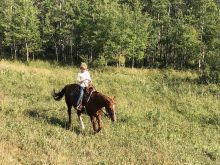There are many old grass stands that are mainly brome grass and serve as hayfields with occasional grazing. Many hayfields have never seen a kernel of fertilizer. Perhaps this piece will start folks thinking and will lead to a change in practice.
There are many old reports that deal with the topic. The two main actors in Alberta and Saskatchewan were John Harapiak of Westco Fertilizers and Harry Ukrainetz of Agriculture and Agri-Food Canada at Scott and Saskatoon, Sask.
If readers want to check out the original reports, they can visit the the University of Saskatchewan website and review the author’s works – John Harapiak and Harry Ukrainetz – dealing with fertilizing grass stands.
Read Also

Claas brings 1000 Series SP forage harvesters to Canada
In mid-August, Claas unveiled its new line of Jaguar forage harvesters at an event in Visalia, California, deep in the heart of that state’s dairy region.
The punch line first
Figure 1 (below) says a lot. It is from Harapiak’s 30-year experiment with brome grass on Black soil north of Calgary. Apply 100 pounds of nitrogen per acre each year and the 16-year average is a fivefold increase in hay yield.

That means one quarter section of fertilized grass could give the same yield as five quarters of “cut what is there.”
Imagine the possibilities.
Urea (46-0-0) and ammonium nitrate (34-0-0)
Ammonium nitrate was a great broadcast fertilizer as it was not subject to volatile loss of ammonium. We no longer have ammonium nitrate as a fertilizer in Western Canada. Ammonium nitrate can explode and was used in the Oklahoma destruction of a large government building many years ago. They still have ammonium nitrate in Ontario.
Urea is subject to volatile loss of ammonium but experiments by Ukrainetz showed the difference between urea and ammonium nitrate as a fertilizer for grass was not huge and often there was little difference.
Rainfall timing is a big issue. If you apply urea and an inch or more of rain comes along in the next day or two the urea is “washed in” and all is good.
If you have urea and a floater handy, and you have the flexibility to apply it just ahead of a significant forecast rain, volatile losses will not be a big issue.
I did that many years ago on my Dundurn farm with a sulphur-deficient canola crop. We floated on 100 pounds per acre of sulphate fines (21-0-0-24) when one inch of rain was forecast. It actually rained 1.75 inches and the sulphur response was evident in less than a week.
What about phosphorus fertilizer?
As shown in Figure 2 (below), Ukrainetz found that an initial application of approximately 80 pounds of P2O5 per acre brought hay yields to a new level. In recent years, we have learned the same thing will happen with annual crops.

What about applying very high nitrogen rates once?
A single application of very high nitrogen rates can result in many years of nitrogen response but there are some potential serious problems with that approach including the large initial outlay. High nitrates in the hay can be toxic to livestock and high nitrogen rates can make the soil acidic.
Fast-forward to 2022: Work by Sask Ag
At the Saskatchewan Agronomy Research Update meetings in December 2022, it was my pleasure to see a presentation by Jordan Johnson of Saskatchewan Agriculture in Swift Current.
In 2022, she completed fertilizer experiments on old forage stands at Weyburn, Sask., on a tough, Trossachs loam, Dark Brown, Solonetzic soil and on an Oxbow loam, Black soil at Yorkton, Sask. She used urea at 68 pounds of nitrogen per acre in a mixed fertilizer with phosphorus and potassium but included a urease inhibitor and nitrification inhibitor.
The results in hay dry matter in pounds per acre can be found in Table 1 (below).

It is only one year of data but is interesting and worth a closer look. Thanks to Jordan for providing me with extra details. If readers wish to contact Jordan, you can email her at [email protected] or call her at 1-306 741-6800.
Getting started
To keep it simple, you can start by broadcasting urea (46-0-0) at approximately 220 pounds per acre, which will give you about 100 pounds of nitrogen per acre. You can start with a few strips in a field or quarter section just to observe the response. Do it early in the spring or just before a significant rain forecast. Rain is needed to wash the urea to the roots.
On very sandy soils, potassium may be a problem and on Grey Wooded soils sulphur deficiency is common, so a soil test is a good place to start.
Good luck and I hope you have a lot of work hauling away the extra bales of hay. As spring field work starts, always remember safety first, so you will be around to do the harvest as well.
















